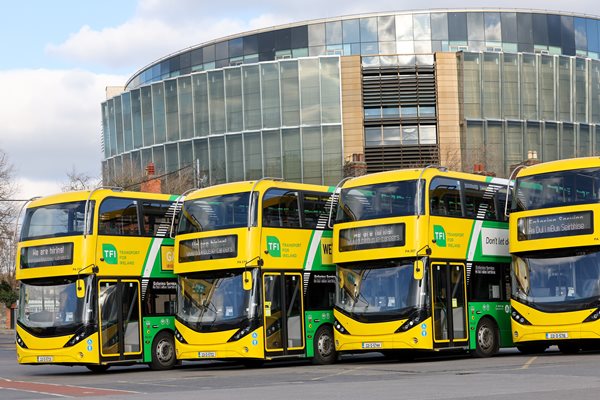The National Transport Authority (NTA) bought 134 brand new all-electric buses in June 2022 for use in Dublin. There are 100 new double-decker buses and 34 single-deck electric buses in storage around the city, but none are in use because the NTA failed to get planning permission for the charging infrastructure to enable them to operate. An NTA spokesperson said that the project to plan, commission and seek planning approval for the infrastructure is now “under way”. The buses cost us at least €50 million and we don’t yet know the cost of the unbuilt charging infrastructure.
These buses will not be on the streets until the substations and charge points are installed. Planning permission, it seems, must await precise specification of the proposed infrastructure. Registering the vehicles for road use is also “now under way”. They will use the chargers already installed for existing hybrid buses in the fleet to train drivers over the coming months. The testing and training phase will last “about three months”.
Maybe they will manage to get the buses into service in early 2024, but that will be done on an “incremental basis”.
This shambles is what bureaucratic Ireland describes as “rolling out” new programmes and projects. In the meantime, the buses lie idle and the people whose job it was to plan and install the charging infrastructure in tandem with the ordering and purchase sit at their desks. Or maybe they are working from home these days.
Should this surprise us? The Public Accounts Committee (PAC) recently published a report which merits close reading. The document, which is based on the work of the Comptroller and Auditor General’s office, reveals that what is termed “ineffective” expenditure on planning transport services in Dublin now exceeds €150 million.
On the Metro North project, the report tells us that up to the end of 2014, approximately €157 million was spent on planning and design, of which €99 million must be regarded as wasted. €18.7 million spent on planning the abandoned Metro West project must be written off. And approximately €32 million spent on planning the Dart Interconnector must also be regarded as a write-off.
And for some reason, the redesigned MetroLink budget has risen from an announced €3 billion five years ago to perhaps €21 billion. Moreover, it will now have its southern terminus at the always-congested Grand Parade on the canal with another entrance on an obscure side road called Dartmouth Road.
There is a large problem with controlling State expenditure on transport programmes. The NTA has spent €88 million on BusConnects so far. Eamon Ryan’s Department of Transport indicated in March 2022 that the Dublin BusConnects programme will consume between €2.6 billion and €3.3 billion in the next seven years. There is still no evidence that the programme has improved or will improve things in terms of an accessible and convenient bus network.
The PAC report raises fundamental questions about cost controls and value for money across the State’s transport plans.
The State, in the form of the same Department of Transport, also negotiated a 10-year deal for the provision of search and rescue (Sar) helicopter services with a price tag of nearly €I billion including VAT by the contract expiry date. The department selected a preferred tenderer in May for a successor 10-year Sar deal — to cost approximately €670 million excluding VAT — but that has been challenged by the incumbent. Meanwhile, the PAC is asking whether the State might purchase rather than lease helicopters.
That in turn raises the issue of our defence forces. You might think that the Air Corps would have been the obvious candidate to furnish a Sar service for the Irish people. Is it not capable of providing one?
While we debate the theory of Irish neutrality in the media, the sad fact is that the Republic has been becoming increasingly defenceless.
There is no full-time Minister for Defence these days. The Defence Forces are greatly under strength. There is real difficulty with retention of personnel. We recently adopted a proposal to enhance the capacity of the Defence Forces which was the middle-way option outlined by the Commission on the Defence Forces.
The reserve defence force is massively understrength. There was a time in the last 30 years when our third-line defence, the FCA [Local Defence Force], numbered up to 20,000. Those people were trained volunteers who were able to come to the aid of government in the context of the Troubles as a disciplined and armed force. Where would that manpower come from now in the event of a security crisis or emergency? The Garda Reserve has been allowed to wither away, from 1,100 to about 300. Civil Defence volunteer membership is down from 4,500 in 2016 to less than 2,500 today. Why? It is all a question of basic effectiveness in the State’s governance and capacity to deliver. This is the constitutional responsibility of our elected Ministers. And yet it appears to be greatly lacking.

